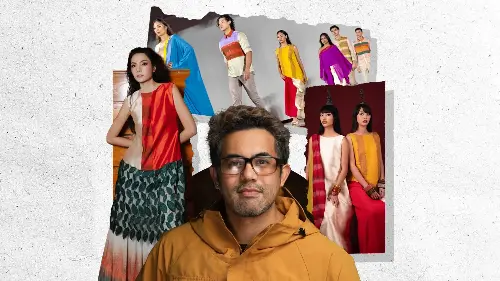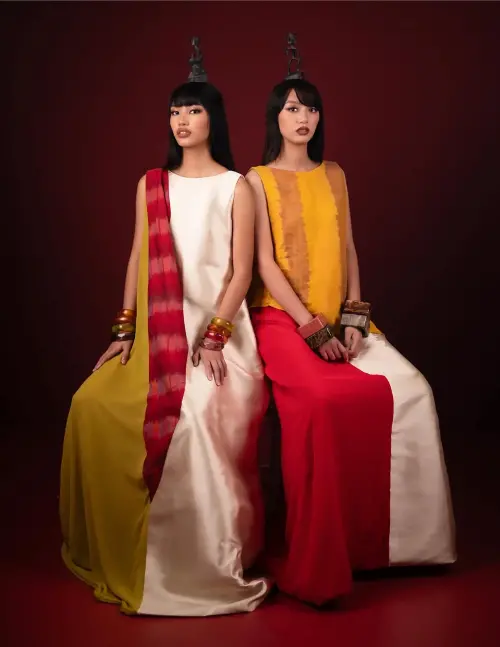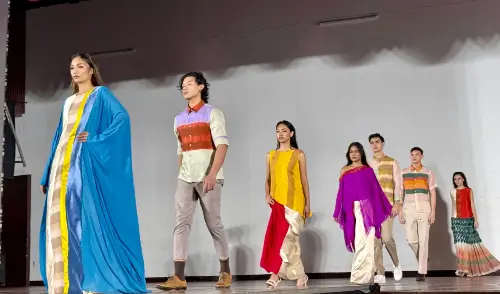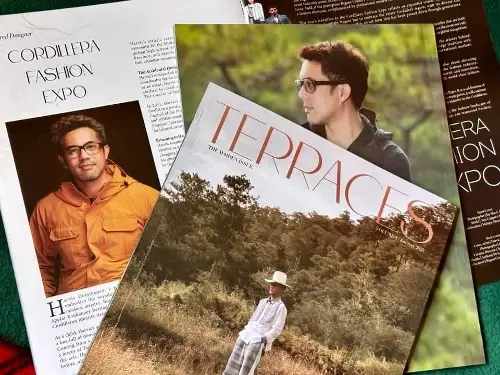
BAGUIO CITY, Philippines – Imagine the hues of Cordillera’s handwoven fabrics strutting down a modern runway.
That’s precisely the spectacle that unfolded at the DECADA fashion show, a celebration marking a decade of innovation by Baguio-born designer Harvic Dominguez.
Harvic’s journey began in the heart of the Cordilleras. Born to an Applai-Kankanaey family, he was surrounded by the rich tapestry of his indigenous heritage.
While his father served as a mayor in Tadian during the 1980s, young Harvic was more inclined towards the arts than politics. His early years were filled with sketches and doodles, hinting at a budding creative talent.
During high school, Harvic’s flair for art led him to become an editorial cartoonist for the Baguio Midland Courier, one of the city’s esteemed publications. This role not only honed his artistic skills but also deepened his connection to the local community.
Frequent moves between Baguio, Mountain Province, and Manila exposed him to diverse cultures, enriching his perspective and fueling his passion for design.
An accidental designer
Harvic’s foray into fashion was serendipitous. While coordinating an event, a designer’s no-show prompted him to improvise.
With a dash of creativity, he deconstructed thrifted clothes, locally known as ukay-ukay, crafting an impromptu collection that wowed attendees. This unexpected success ignited his career in fashion design.
In 2011, Harvic’s talent caught national attention when he became a finalist in a prestigious competition organized by the Fashion Design Council of the Philippines.
This exposure opened doors to collaborations with magazines and stylists, and an apprenticeship under a Filipino-Canadian designer. Here, he embraced the philosophy that “less is more,” refining his approach to tailored, structured clothing.

Embracing his roots
Despite his growing success, Harvic felt a pull towards home. He returned to Baguio, aiming to infuse his designs with Cordilleran essence.
The winding roads of Halsema Highway, the shifting seasons, and the traditions of his people became his muse. He began collaborating with local artisans, particularly those from Narda’s Handwoven Arts and Crafts, a name synonymous with high-quality Cordilleran craftsmanship.
Harvic’s designs seamlessly blend modern aesthetics with traditional weaves, creating pieces that resonate with both local and global audiences. His commitment to showcasing indigenous textiles not only elevates the art of weaving but also provides a platform for local weavers to gain recognition beyond the highlands.
“I continue to support Cordilleran weaving in all my works, as it’s a vital part of our heritage. But beyond that, my vision is to elevate the local fashion scene by introducing new designs that combine tradition with contemporary techniques,” he said.
“My commitment to innovation and cultural preservation, and my ability to merge heritage fabrics with forward-thinking design, is the ultimate goal.”

A show called DECADA
The DECADA fashion show was more than a celebration; it was a testament to Harvic’s dedication to his craft and culture.
The event featured five segments, over 60 models, and a collaboration with acclaimed fashion photographer Eros Goze. Together, they launched Terraces Magazine, a publication that pays homage to the people, landscapes, and traditions of the Cordilleras.
One standout segment, “Spectrum,” showcased bold, vibrant colors harmonizing with Narda’s handwoven textiles. It was a visual feast that highlighted the versatility of traditional fabrics in contemporary fashion.
Harvic’s designs challenge the notion that indigenous culture is static; instead, he presents it as evolving, dynamic, and deeply intertwined with modern artistry.
Reflecting on the event, Harvic shared, “I cannot put into words how happy my team and I are with the turnout of the Cordillera Fashion Expo and Terraces Magazine. We are immensely grateful for the collaborative support from everyone who made this event a success.”
He added, “While our beliefs and ideals may differ, what makes our region thrive is our unique and innate sense of unity — embracing our culture and showing unwavering support for our arts and artisans. This unity reflects a maturity and dynamism that continue to drive progress in our community.”

Championing Cordilleran culture
Harvic’s work aligns seamlessly with Baguio City’s designation as a UNESCO Creative City for Crafts and Folk Arts, a recognition it received in 2017.
This honor acknowledges Baguio’s rich traditions in weaving, woodcarving, silver crafting, and tattooing. Through his designs, Harvic contributes to the city’s vibrant creative scene, ensuring that Cordilleran heritage remains alive and influential.
Beyond his personal achievements, Harvic envisions a future where young and upcoming Cordilleran designers are given opportunities to grow and thrive.
“As we work to elevate the arts and fashion industry of the Cordilleras, may we remain united in supporting one another, especially the young and upcoming designers and artists. With proper guidance, we can collectively create better opportunities while promoting our culture and arts with respect and integrity.”

The future woven in tradition
As Terraces Magazine makes its mark as a platform for Cordilleran creatives, its editorial team — editor in chief Tedd Mabitazan, art director Jay Mar Dait, executive editor Paolo Carantes San Juan, and contributors Eros Goze and Jay Mar Dait — aims to champion the region’s unique artistic identity.
Harvic’s passion for Cordilleran culture continues to fuel his work.
“Through my designs, I want to show that our culture is not static — it evolves, just like fashion,” he said. His creations are more than garments; they are narratives that weave together identity, history, and community.
As he continues to champion local artisans and indigenous textiles, Harvic Dominguez stands as a champion of Cordilleran pride, inspiring a new generation to embrace and celebrate their heritage.
“Iya-iyaman!” he exclaims, a heartfelt expression of gratitude that echoes across the highlands and beyond. – Rappler.com
